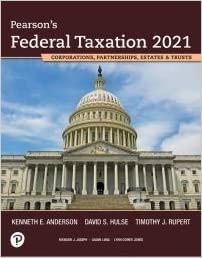Although the text does not cover reverse triangular mergers in any detail, this problem gives you an
Question:
Although the text does not cover reverse triangular mergers in any detail, this problem gives you an opportunity to (1) critically read selected IRC sections that define a Type B reorganization and a reverse triangular merger and (2) evaluate a transaction in light of those IRC definitions.
IRC Sec. 368(a)(1)(B) defines a Type B reorganization as follows:
[T]he acquisition by one corporation, in exchange solely for all or a part of its voting stock …, of stock of another corporation if, immediately after the acquisition, the acquiring corporation has control of such other corporation ….
IRC 368(a)(2)(E) defines a reverse triangular merger as follows:
A transaction otherwise qualifying [as a Type A reorganization] shall not be disqualified by reason of the fact that stock of a corporation (referred to in this subparagraph as the “controlling corporation”) which before the merger was in control of the merged corporation is used in the transaction, if—
(i) after the transaction, the corporation surviving the merger holds substantially all of its properties and of the properties of the merged corporation (other than stock of the controlling corporation distributed in the transaction); and
(ii) in the transaction, former shareholders of the surviving corporation exchanged, for an amount of voting stock of the controlling corporation, an amount of stock in the surviving corporation which constitutes control of such corporation. In each of these definitions, control means at least 80% ownership. In the reverse triangular merger definition, the “merged corporation” is a subsidiary of the “controlling corporation” that merges into the target corporation using its parent’s stock and then disappears.
Now, consider the following facts. Pi Corporation wishes to acquire all the stock of Tau Corporation from its owner, Terry. The Tau stock has a $250,000 FMV, and its shareholder, Terry, has a $100,000 basis in the Tau stock. In the transaction, Terry is willing to accept Pi voting stock in the exchange but also wants $50,000 cash in addition to the Pi stock. Pi wants Tau to be its subsidiary after the transaction. Critically analyze the alternatives and make a recommendation to the parties to the transaction.
Step by Step Answer:

Federal Taxation 2021 Corporations, Partnerships, Estates & Trusts
ISBN: 9780135919460
34th Edition
Authors: Timothy J. Rupert, Kenneth E. Anderson, David S. Hulse





